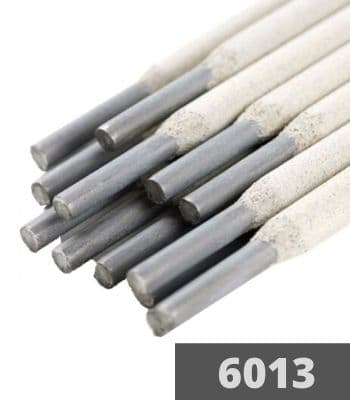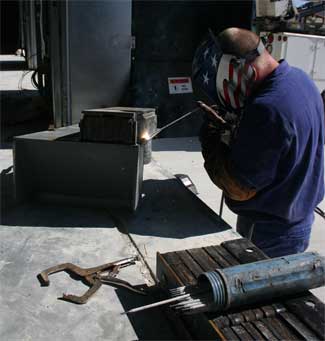In Brief: 6013 VS 7018 Welding Electrodes
The electrodes are very popular electrodes used for welding applications like shipbuilding, construction, fabrication, and maintenance. The most important difference between the two is that the 613 can weld through various contaminants like rust or dirt. The 7018, however, provides better weld quality and ease of use with the takeaway of only being able to operate on clean surfaces. The 7018 also has better strength and elongation characteristics as compared to 6013.
A welding wire is a metallic rod which is utilized to produce a heated arc for the purpose of joining metals through the process of welding.
These wires are gas-shielded electrodes with an array of characteristic mechanical and chemical properties, arc behaviour, quality, and cost.
Wires also come in various diameters and are usually chosen on the basis of the welder being used and the material of the job.
The following sections will provide essential information on both the products.
Overview of 6013 Electrode Rods

The 6013 is a general-purpose welding electrode made of mild steel and can be used in all positions of a welding process. The electrode delivers a smooth and medium penetrating arc.
The electrode can be used with small AC power sources having low open-circuit voltage as well.
The 6013 finds its applications in vehicles, shipbuilding, and repair, sheet metal, the build-up of over-machined and worn mild steel surfaces and general light fabrication.
The 6013 also facilitates a quiet arc that is readily maintained with minimal spatter loss. The slag produced from the process lifts easily and delivers finely rippled bead contour.
The electrode’s quick freezing slag provides optimum performance while welding in the vertical down position. The electrode is largely used for welding clean, new sheet metal.
The wire is a mild steel electrode coated with high Titania potassium. The coating aids in producing a spray-type arc which results in deep penetrating welds. The wire has low elongation as compared to others in its category.
With a 60,000 psi and 48,000 psi tensile and yield strength respectively, the wire provides ample quality in the job welds.
| Parameters | Details |
|---|---|
| Material | Mild Steel |
| Wire Coating | High titania potassium |
| Tensile Strength | 60,000 psi |
| Yield Strength | 48,000 psi |
| Elongation | 17 % |
| Position | All-position |
Pros
- Great weld quality
- All-position electrode
- Quick freezing slag provides optimum performance
Cons
- Lower strength characteristics
Overview of 7018 Electrode Rods
Source: Miller
The 7018 is a DC all-position electrode which is mostly used when the welder requires high levels of polish in their welds on difficult to melt metals. It is a high deposition electrode suitable for low and medium carbon steels.
The electrode is an iron powder, low hydrogen electrode with prominent mechanical properties that make the wire crack resistant and help provide x-ray quality welds.
The 7018 has the capability of delivering uniform welds on metal and has better impact properties at temperatures below zero.
This is precisely why the 7018 is used for ship hull construction, pressure vessels, boilers, piping, heavy-duty equipment, maintenance, production or fabrication.
The wire is used for jobs that require low penetration and facilitates a quiet and spatter-free arc.
The electrode is considered more of a “drag” rod, the 7018 is also commonly known as a low-hydrogen or “low-high” rod in the field.
A number of hardware shops, field welders, and home hobbyists often fail to stock the 7018 rods properly. The electrode is a low-hydrogen rod, requires a moisture-free environment so that the flux stays protected from it.
The flux contains a very scarce amount of hydrogen, and the electrode produces smooth welds that are ductile by nature.
This is the reason why the 7018 is also used extensively in structural welding, for instance, in a shopping complex, nuclear or other energy power plants, factories, powerhouses, dams, and bridges.
| Parameter | Details |
|---|---|
| Material | Mild Steel |
| Wire Coating | Low hydrogen potassium Iron powder |
| Welding Current | AC, DC+ or DC- |
| Tensile Strength | 70,000 psi |
| Yield Strength | 58,000 psi |
| Elongation (in 2 inches) | 22 % |
Pros
- Quieter operation
- Splatter free arc
- Stable arc
- High weld quality
Cons
- Low penetration
- Requires additional storage
Key Differences between 6013 and 7018
While both the wires can be used for applications like construction, maintenance, production, fabrication, shipbuilding or construction, there are certain key things that need to be remembered for the welders.
While both the wires are mild steel based, the coating on both are very different, the 7018 has a low hydrogen potassium coating whereas the coating on the 6013 is high Titania potassium.
The electrodes also differ in yield and tensile strength, the 7018 has higher specifications in both. The 7018 also has a higher elongation of 22 percent in 2 inches.
| 7018 | 6013 | |
|---|---|---|
| Material | Mild Steel | Mild Steel |
| Wire Coating | Low hydrogen potassium Iron powder | High titania potassium |
| Welding Current | AC, DC + or DC - | AC, DC + |
| Tensile Strength | 70,000 psi | 60,000 psi |
| Yield Strength | 58,000 psi | 48,000 psi |
| Elongation (in 2 inches) | 22 % | 17 % |
Summary
While welding, the 6013 has a deeper penetration than the 7018 on the surface of the job that the user is operating on. The 6013 is harder to operate with but leaves significantly less slag behind as compared to the 7018.
The 6013 also doesn’t require a preparation using an oven to bake the electrodes at 300 degrees Fahrenheit like the 7018. The 7018 needs to have a clean surface for the root pass.
The 7018, on the other hand, is much more accessible to use and produces a consistent quality of welds.
It is preferable to use the 7018 when the base metal is easily reachable. The 7018 delivers a much more stable arc and does not require much oscillation.


Nice love All the extra information i csn get
Thanks for the very helpful information – much appreciated.
That’s a very helpful for me
Thanks